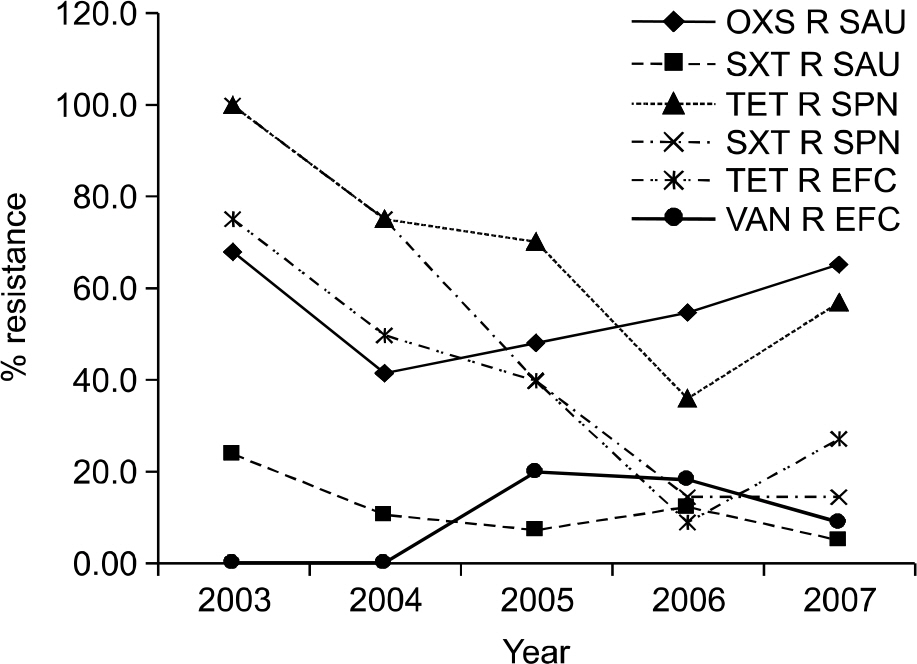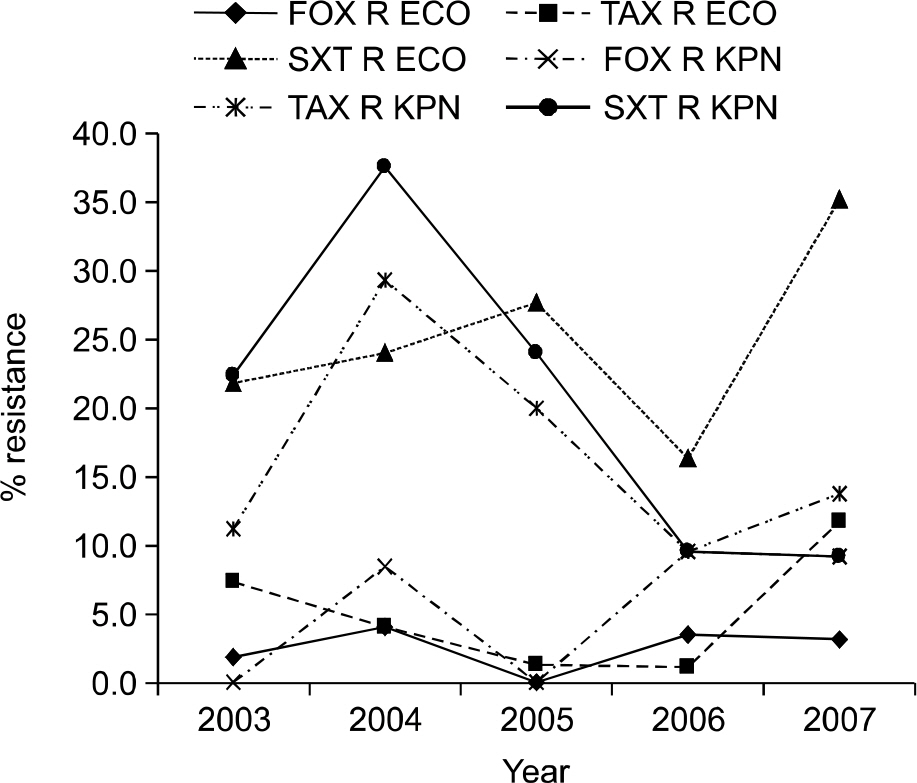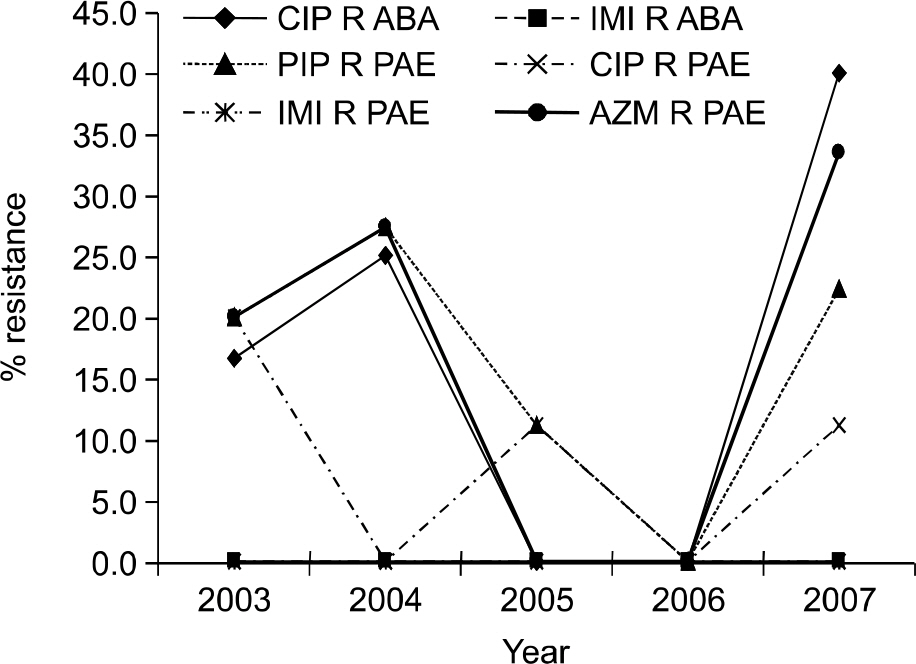Characteristics of Microorganisms Isolated from Blood Cultures at a University Hospital Located in an Island Region During 2003~2007
- Affiliations
-
- 1Department of Laboratory Medicine, College of Medicine, Cheju National University, Jeju, Korea. namu8790@empal.com
- KMID: 2089802
- DOI: http://doi.org/10.5145/KJCM.2008.11.1.11
Abstract
-
BACKGROUND: The referral hospital is somewhat isolated from the mainland due to its island status; thus, microorganisms isolated from blood cultures might have a distinct pattern in their frequency and antibiogram. We attempted to uncover these characteristics.
METHODS
The isolates from blood cultures at the Cheju University Hospital during 2003~2007 were analysed. After inoculation in aerobic and anaerobic bottles, blood specimens were cultured using BacT/ Alert system, and the isolates were identifieded and antimicrobial susceptibilities were tested using Vitek II system.
RESULTS
The overall positive rate of blood cultures was 9.6% and contamination rate was 3.6%. The most commonly isolated pathogens were Escherichia coli, Staphylococcus aureus, and Klebsiella pneumoniae. Gram positive rod, gram negative cocci, and anaerobes were not isolated, but fungi were isolated in 0.6% of blood cultures. The prevalence of methicillin-resistant S. aureus (MRSA) was 68.0% in 2003, 41.4% in 2004, 48.1% in 2005, 54.5% in 2006, and 65.2% in 2007. The prevalence of vancomycin-resistant enterococcus (VRE) was 0% in 2003 and 2004, 16.7% in 2005, 10.0% in 2006, and 9.5% in 2007.
CONCLUSION
The most commonly isolated pathogens were similar to those from other hospitals, but the isolation rates of MRSA and VRE by year showed different patterns. Also, gram positive rods, gram negative cocci and anaerobes were not isolated. To help the choice of empirical antibiotic treatments, we need complementary measures to upgrade microorganism isolation systems and further studies including the monitoring of antibiotic use.
MeSH Terms
Figure
Cited by 6 articles
-
Development of Blood Culture and Quality Improvement
Sunjoo Kim
Ann Clin Microbiol. 2013;16(4):153-161. doi: 10.5145/ACM.2013.16.4.153.Trends in Bloodstream Infections at a Korean University Hospital between 2008 and 2013
Tae Sang Oh, You Sun Nam, Young Jin Kim, Hyung-seok Yang, Min-young Lee, Hyun Jung Gu, Hee Joo Lee
Ann Clin Microbiol. 2015;18(1):14-19. doi: 10.5145/ACM.2015.18.1.14.Antimicrobial Resistance of Enterococcal Isolates from Blood and Risk Factors for Vancomycin Resistant Enterococcal Bacteremia in a Tertiary Care University Hospital from 2003 to 2007
Kyung Sun Park, Myeong Hee Kim, Tae Sung Park, Jin Tae Suh, Hee Joo Lee
Korean J Clin Microbiol. 2010;13(2):59-67. doi: 10.5145/KJCM.2010.13.2.59.Characteristics of Microorganisms Isolated from Blood Cultures at Nine University Hospitals in Korea during 2009
Hee-Jung Kim, Nam Yong Lee, Sunjoo Kim, Jeong Hwan Shin, Mi-Na Kim, Eui-Chong Kim, Sun Hoi Koo, Nam Hee Ryoo, Jae-Seok Kim, Ji-Hyun Cho
Korean J Clin Microbiol. 2011;14(2):48-54. doi: 10.5145/KJCM.2011.14.2.48.The Impact of the Antibiotic Burden on the Selection of its Resistance among Gram Negative Bacteria Isolated from Children
Seohee Kim, Reenar Yoo, Jina Lee
Pediatr Infect Vaccine. 2015;22(3):178-185. doi: 10.14776/piv.2015.22.3.178.Comprehensive Analysis of Blood Culture Performed at Nine University Hospitals in Korea
Jeong Hwan Shin, Sae Am Song, Mi-Na Kim, Nam Yong Lee, Eui-Chong Kim, Sunjoo Kim, Sun-Hoi Koo, Nam Hee Ryoo, Jae-Seok Kim, Ji-Hyun Cho
Korean J Lab Med. 2011;31(2):101-106. doi: 10.3343/kjlm.2011.31.2.101.
Reference
-
References
1. Bryan CS. Clinical implications of positive cultures. Clin Microbiol Rev. 1989; 2:329–53.2. Lee GI, Hong KS, Kim OK. Results of blood cultures at Ewha Womans' University Hospital in Recent 5 years. Korean J Lab Med. 1988; 8:169–75.3. Ahn GY, Jang SJ, Lee SH, Jeong OY, Chaulagain BP, Moon DS, et al. Trends of the species and antimicrobial susceptibility of microorganisms isolated from blood cultures of patients. Korean J Clin Microbiol. 2006; 9:42–50.4. Koh EM, Lee SG, Kim CK, Kim M, Yong D, Lee K, et al. Microorganisms isolated from blood cultures and their antimicrobial susceptibility patterns at a university hospital during 1994–2003. Korean J Lab Med. 2007; 27:265–75.
Article5. National Nosocomial Infections Surveillance System. National Nosocomial Infections Surveillance (NNIS) System Report, data summary from January 1992 through June 2004, issued October 2004. Am J Infect Control. 2004; 32:470–85.6. National Committee for Clinical Laboratory Standards. Performance standards for antimicrobial susceptibility testing; tenth informational supplement M 100-S10. Wayne, PA; National Committee for Clinical Laboratory Standards. 2005.7. Kim HO, Kang CG, Chong YS, Lee SY. Organisms isolated from blood at the Yonsei medical center. 1974–1983. Infect Chemother. 1985; 17:15–32.8. Kim HK, Lee KW, Chong YS, Kwon OH, Kim JM, Kim DS. Blood culture results at the Severance Hospital during 1984–1993. Infect Chemother. 1996; 28:151–66.9. Mylotte JM and Tayara A. Blood cultures: clinical aspects and controversies. Eur J Clin Microbiol Infect Dis. 2000; 19:157–63.10. Goldstein EJ. Anaerobic bacteremia. Clin Infect Dis. 1996; 23:S97–101.
Article11. Edmond MB, Wallace SE, McClish DK, Pfaller MA, Jones RN, Wenzel RP. Nosocomial bloodstrem infections in United States hospitals: a three-year analysis. Clin Infect Dis. 1999; 29:239–44.13. Kim KA, Shin SM, Moon HG, Park YH. Causative organisms of neonatal sepsis. Yeungnam Univ J Med. 1999; 16:60–8.
Article14. Orrett FA and Changoor E. Bacteremia in children at a regional hospital in Trinidad. Int J Infect Dis. 2007; 11:145–51.15. Uh Y, Lee HH, Lee KW, Chong YS. The species and antimicrobial susceptibility of microorganisms isolated from blood cultures of patients. J Korean Soc Microbiol. 1991; 26:417–30.16. Leclercq R, Derlot E, Duval J, Courvalin P. Plasmid-mediated resistance to vancomycin and teicoplanin in Enterococcus faecium. N Engl J Med. 1988; 319:157–61.
Article17. Hong SG, Kim S, Jeong SH, Chang CL, Cho SR, Ahn JY, et al. Prevlence and diversity of extended-spectrum β-lactamase -producing Escherichia coli and Klebsiella pneumoniae isolates in Korea. Korean J Clin Microbiol. 2003; 6:149–55.
- Full Text Links
- Actions
-
Cited
- CITED
-
- Close
- Share
- Similar articles
-
- Trends in Five-year Blood Cultures of Patients at a University Hospital (2003~2007)
- Trends of Antimicrobial Susceptibility Test for Bacterias Isolated from Blood, Urine, Stool, and Cerebrospinal Fluid(1997~2001)
- The species and antimicrobial susceptibility of microorganisms isolated from blood cultures of patients
- A Multicentre Study about Pattern and Organisms Isolated in Follow-up Blood Cultures
- Trends in Bloodstream Infections and Antimicrobial Susceptibilities at a University Hospital in Korea Between 2007 and 2016




